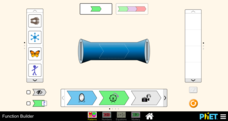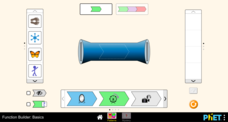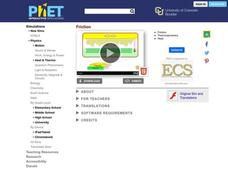PHET
Function Builder
Build confidence about functions with the function builder. Pupils learn about functions and transformations using an interactive. A function machine transforms pictures, numbers, and equations based on a function rule. A mystery...
PHET
Graphing Lines
Ready to increase pupils' understanding of slope with an upward slope? Scholars use an interactive that allows users to move two points on a coordinate plane. The interactive then automatically calculates the slope, the slope-intercept...
PHET
Function Builder: Basics
Learn about functions using the function builder app. A fun online interactive has the class conduct an investigation using a function machine. Inputs are pieces of art, and output are transformations of these pieces of art.
PHET
Resistance in a Wire
Resistance is not futile, it is voltage divided by current. A creative simulation presents a wire graphic and allows participants to alter the area, length, and resistivity. As scholars increase or decrease a variable within the...
PHET
Wave Interference
Why did the waves get into a fight? They were tired of each other's interference. Scholars observe the wave patterns from dripping water, sound waves, and light waves. They vary the spacing, build barriers, and increase the number of...
PHET
Molecules and Light
Does light affect molecules or does it go right through them? The simulation explores four different types of light: microwave, infrared, visible, and ultraviolet. Scholars alter the energy level of each as it is aimed at seven different...
PHET
Gravity Force Lab
Does size or mass impact gravitational pull? Scholars experiment with force pairs to answer that question. They can change the size, mass, and distance between the objects using an engaging simulatoin. This allows pupils to visualize the...
PHET
Geometric Optics
What would happen if your entire world was flipped upside down? In addition to changing the distance and size of an object, lenses flip the image upside down. The simulation allows scholars to vary the object, move the object, move the...
PHET
Gas Properties
We can't see most gases and we can't see things at the molecular level — but that's about to change! A simulation shows pupils the activity of molecules in a gas. The simulation allows scholars to vary the volume, heat, and gravity in a...
PHET
Under Pressure
Do you work better under pressure? Pupils explore pressure when altering fluid density, gravity, container shape, and volume. Units can be converted to kPa, atm, and psi. To finish, scholars describe pressure as a function of depth,...
PHET
Pendulum Lab
How would a pendulum work on the moon or Jupiter? To answer that question scholars control up to two pendulums including their location, length, mass, and amplitude. Added controls include changing the friction and strength of gravity....
PHET
Friction
Friction leads to movement, heat, and melting on such a small scale most people don't notice. A short simulation permits scholars to observe the reaction between atoms as they move together. The simulation applies the concept of...
PHET
Generator
Michael Faraday was self-educated, earned an honorary doctorate from the University of Oxford, invented the first Bunsen burner, discovered the laws of electrolysis, and proved that a changing magnetic field produces a current. In this...
PHET
Double Wells and Covalent Bonds
Quantum tunneling plays an important role in nuclear fusion, the energy source of the sun. This simulation explores tunneling, double wells, and covalent bonds by allowing individuals to manipulate potential and total energy to learn...
PHET
Conductivity
Human bodies can conduct electricity—that doesn't sound like it would feel good! Learners explore conductivity through the use of this simulation. They see why metals conduct electricity and plastics don't and why some materials will...
PHET
Bending Light
Different colors of the spectrum travel at different speeds through media, causing them to refract at different angles—which allows humans to see their colors. Through a simulation, pupils see how air, water, and other media bend light....
PHET
Alpha Decay
There are different types of radioactive decay, and alpha decay is when there are too many protons in a nucleus. Here is a simulation that shows alpha particles being emitted from a polonium nucleus. Learners see how radioactive decay...
PHET
Color Vision
Humans can only see visible light, but some insects can see ultraviolet light. Through a simulation, pupils explore how we see colors using one bulb. It moves on to demonstrate how we see colors by mixing three different bulbs (red,...
PHET
Capacitor Lab
The first capacitor was a Leyden jar, invented in 1745. Physics scholars explore capacitors in an engaging simulation. They may view one or set up circuits which contain two to three either in series or parallel. Other views include...
PHET
Build an Atom
Scholars build specific elements by creating a model of its atomic structure. Objects they can include are protons, nuetrons, electrons, orbits, clouds, charge, and mass number. Simulation ends with questions to challenge individuals'...
PHET
Battery Voltage
Pupils explore modern batteries and how they work by viewing a simple simulation. It shows electrons moving around the insides and if the voltage is changed, little people move the particles from one end to the other — an entertaining...
PHET
Battery-Resistor Circuit
Don't be resistant to physics! A simulation shows classes how a resistor works. Change the battery voltage and resistance to show how this affects the flow of electrons. Temperature and amps measurements are shown for the system as well.
PHET
Band Structure
Electricity travels at the speed of light, 186,000 miles per second. Through a simulation, classes see how the structure of energy bands in crystals of atoms determines how materials conduct electricity. Participants can change the...
PHET
Balancing Act
How can a teeter-totter balance when the two people are different sizes? Show classes how this works through a simulation. Scholars play with a teeter-totter to show how different masses and their placement affect balance. Once they have...

























